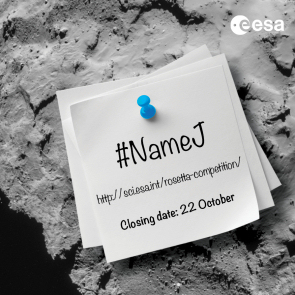Name Rosetta mission's landing site
16 October 2014
ESA and its Rosetta mission partners are inviting you to suggest a name for the site where lander Philae will touch down on Comet 67P/Churyumov-Gerasimenko on 12 November.
 |
As the location of the first soft landing of a human-made object on a comet, the site, currently identified as Site J, deserves a meaningful and memorable name that captures the significance of the occasion.
The rules are simple: any name can be proposed, but it must not be the name of a person. The name must be accompanied by a short description (up to 200 words) explaining why this would make the ideal name for such an historic location.
A jury comprising members of the Philae Steering Committee will select the best name from the entries, and the winning proposer will be invited to follow the landing in person from ESA's mission control centre in Darmstadt, Germany on 12 November.
The competition opens today and will run until 23:59 GMT on 22 October. The winner will be announced on 3 November on the main Rosetta web page (www.esa.int/rosetta), via ESA's social media channels, as well as on the German, French and Italian space agency (DLR, CNES and ASI) web pages and social media channels.
The competition is being run and coordinated by ESA, DLR, CNES and ASI. Entries from all competitions will be considered together, with one winner selected to attend the landing event in Darmstadt.
Full rules, terms and conditions can be found here.
Enter the ESA competition here.
Enter the DLR competition here.
Enter the CNES competition here.
Enter the ASI/INAF competition here.
About Site J
Site J was selected by Rosetta mission scientists and engineers over four other candidates as Philae's primary landing site. The site is close to a distinctive large depression on the smaller 'lobe' of the comet.
Site J is considered to pose minimum risk to the lander compared to the other candidate sites, while offering the opportunity to conduct unique science – regions of activity have been identified nearby. The majority of the terrain within a square kilometre area has slopes of less than 30° relative to the local vertical and there are relatively few large boulders, although, as close-up images show, the site is not completely free of such hazards. The area also receives sufficient daily illumination to recharge Philae and perhaps continue surface science operations beyond the initial 64-hour battery-powered phase.
The landing site selection process could only begin once Rosetta arrived at the comet on 6 August, when Comet 67P/Churyumov-Gerasimenko was seen in detail for the first time. By 24 August, using data collected when Rosetta was still about 100 km from the comet, five candidate regions had been identified for further analysis, from a pre-selection of 10 candidates, A–J.
Over the next three weeks, the spacecraft moved to within 30 km of the comet, allowing more detailed scientific measurements of the candidate sites to be made. In parallel, the operations and flight dynamics teams explored options for delivering the lander to all five candidate sites. After careful consideration of all available information, Site J was selected as the primary site, with Site C as the backup, on 12 September.
Final confirmation of the primary landing site and its landing scenario was made yesterday after a formal Lander Operations Readiness Review, which included the results of additional high-resolution analysis of the primary and backup landing sites from distances of about 20 km.
Rosetta will release Philae at 08:35 GMT/09:35 CET on 12 November at a distance of 22.5 km from the centre of the comet, landing about seven hours later at Site J. Taking into account the signal travel time between Rosetta and Earth on 12 November, confirmation of landing is expected on Earth at around 16:00 GMT/17:00 CET.
More about Rosetta
Rosetta is an ESA mission with contributions from its Member States and NASA. Rosetta's Philae lander is provided by a consortium led by DLR, MPS, CNES and ASI. Rosetta is the first mission in history to rendezvous with a comet. It is escorting the comet as it orbits the Sun and will deploy a lander to its surface.
Learn more about Rosetta at: www.esa.int/rosetta
